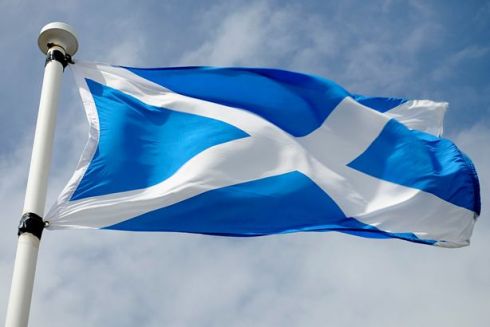I’ve been writing posts on various saints days over the years and yesterday I realized I had never posted about St. Andrew on his feast day, a notable omission both in general and for me, in particular, as I was fortunate to spend my junior year at St. Andrew’s University, and the town remains one of my very favorite places on earth. Though I think most people associate St. Andrew exclusively with Scotland, he is venerated widely: in much of eastern Europe, in the Caribbean and even South America. Andrew was the first Apostle, the brother of Peter, and an ardent missionary: it is said that he continued to spread the gospel during much of his crucifixion, on an x-shaped cross forever associated with his name: the saltire or St. Andrew’s Cross. Such a powerful symbol of assertion, both against a field of blue as the Scottish flag, or as the southern cross on the Confederate flag. The connotations of the former are all positive as compared with the latter, of course, and St. Andrew’s Day has been a bank holiday in Scotland since 2006.


 Late medieval manuscript images of St. Andrew from the British and St. Andrew’s University Libraries; Juan Correa de Vivar, Crucifixion of St. Andrew, c. 1540, University of St. Andrew’s Special Collections; the saltire unfurled.
Late medieval manuscript images of St. Andrew from the British and St. Andrew’s University Libraries; Juan Correa de Vivar, Crucifixion of St. Andrew, c. 1540, University of St. Andrew’s Special Collections; the saltire unfurled.
Scotland’s claim to St. Andrew has always struck me as a little convoluted, but it became official, and lasting, with the Declaration of Arbroath (1320), a letter written by the barons of Scotland to Pope John XXII asking for recognition of the country’s independence and acknowledgment of Robert the Bruce as its rightful king. Scotland’s “Declaration of Independence” incorporated the esteemed St. Andrew as part of its plea, for “The high qualities and deserts of these people, were they not otherwise manifest, gain glory enough from this: that the King of kings and Lord of lords, our Lord Jesus Christ, after his Passion and Resurrection, called them, even though settled in the uttermost parts of the earth, almost the first to His most holy faith. Nor would He have them confirmed in that faith by merely anyone but by the first of His Apostles – by calling, though second or third rank – the most gentle Saint Andrew, the Blessed Peter’s brother, and desired him to keep them under his protection as their patron for ever.” Another very powerful assertion, as St. Andrew certainly outranked the emerging patron saint George of Scotland’s perennial enemy, England. Combined with a classical origins story, language, literature, Presbyterianism, the “auld alliance” with France, and myriad other claims and customs, St. Andrew helped Scotland preserve a very distinct national identity even after it became part of Great Britain. And then, in that golden age of romantic nationalism that was the nineteenth century, the Saint and his cross seem to be emblazoned on all forms of material culture associated with Scotland, transforming him into a more secular patron and ensuring his survival into the modern age.




The symbolic British Empire in glass, c. 1840: stained glass panels by C.E. Gwilt representing St. Andrew of Scotland, St. Patrick of Ireland, and St. George of England; a Minton tile, c. 1875; Walter Crane’s “National” wallpaper, 1890s, all collection of the Victoria and Albert Museum; St. Andrew’s Day 2013 in Edinburgh.






November 30th, 2016 at 5:48 pm
I could never grasp why religion, whether intentionally or not, glorifies torture. I went to Catholic School, kindergarten through 12th grade and we had to go to church every day before school. The life size crucifix with tortured Jesus just horrified me. Even to this day I have crucifixion nightmares. Never could understand why the torture device and implement of Christ’s death was chosen to be the grand symbol of the church. It would be like using a bullet to memorialize John F. Kennedy. Imagine if bullets were festooned over all things Kennedy like the crucifix is with Christianity.
November 30th, 2016 at 7:26 pm
Martyrdom, sacrifice, conviction–very powerful–unfortunately the pain endured is a key way to emphasize these things.
November 30th, 2016 at 7:40 pm
Jesus secretly wants to smite everyone using the cross to idolize him. That’s just bad form all the way around.
November 30th, 2016 at 7:49 pm
Well a lot of dogma happened AFTER Jesus……
November 30th, 2016 at 8:08 pm
Indeed! I agree with you.
Because of my constant exposure to tortured Jesus for as far back as I have memories I’m thinking it’s not very kind to expose wee children to such murder horror. I have recurring nightmares about my family, friends and I being crucified in a multitude of modern scenarios, finding myself wondering if others who were indoctrinated in the same manner experience the same affliction.
December 6th, 2022 at 8:29 am
I had the exact opposite encounter as a child with the crucified Christ. As I stared at our Saviors great sacrifice for humanity, I learned to be ever grateful to God and to work hard to sin no more. As I grew up, I also learned that in early Christianity, the crucifix was the symbol of defiance as this Roman torture was overcome with the resurrection and represented the good news of salvation and overcoming death. I love the image more and more each day.
December 12th, 2016 at 2:42 pm
[…] via St. Andrew’s Cross — streetsofsalem […]